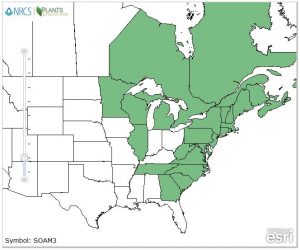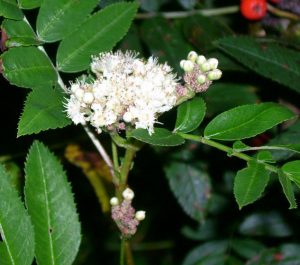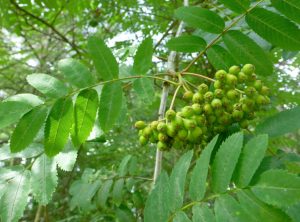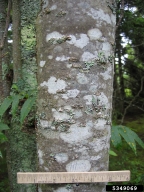American Mountain Ash Fact Sheet

Mountain ash is a tree species that is native to eastern North America. It can be found from Canada south to the mountains of Georgia and can be found as far
west as Minnesota. Mountain ash prefers moist soil and full sunlight, growing along forest edges, roadsides and swamp areas. Height will vary based on conditions, but generally ranges from 10-30 ft.
The ash serves multiple roles within the ecosystem. In addition to providing shelter, it is a source of food for a variety of forest organisms. Moose and white-tailed deer feed on the leaves, twigs and branches. Smaller
mammals and birds consume the red berries.

Humans monitor this species for both its function in the ecosystem and its potential effect on human health as an allergen.
Leaves: Leaflets with serrated edges grow in the form of compound leaves with an alternate pattern along the trunk. They are dark green in color, narrow and 2-2 ½ in long.
Flowers: Small, white flowers grow in clusters that are 3-5 in across. Flowering occurs between May and July.
Fruit: Mountain ash produces small red berries that ripen in August and remain on the tree through early winter.


Bark: On younger trees, the bark is gray and smooth. With age, the bark becomes scaly in appearance.
Sources and Additional Information:
USDA, NRCS. 2014. The PLANTS Database (http://plants.usda.gov, 22 October 2014). National Plant Data Team, Greensboro, NC 27401-4901 USA.
Sullivan, Janet. 1992. Sorbus americana. In: Fire Effects Information System, [Online]. U.S. Department of Agriculture, Forest Service, Rocky Mountain Research Station, Fire Sciences Laboratory (Producer). Available: http://www.fs.fed.us/database/feis/ [2014, October 20].
Missouri Botanical Garden. Plant Finder. http://www.missouribotanicalgarden.org/
